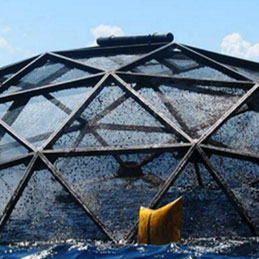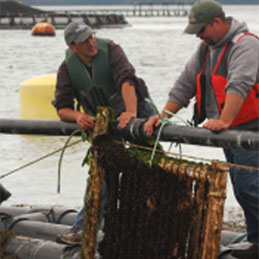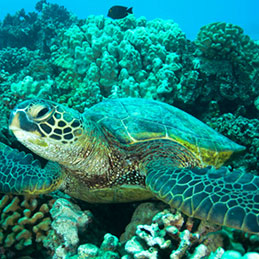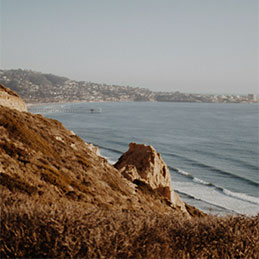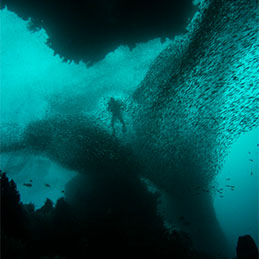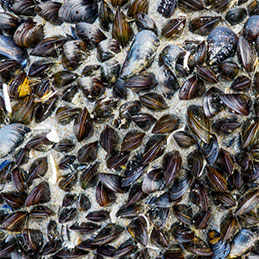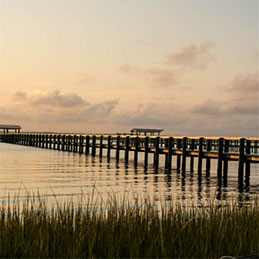Environmental Interactions
NCCOS research helps us understand interactions between aquaculture and the environment to determine how aquaculture can grow waterfront communities, improve ecosystem health, and provide a sustainable seafood supply.
Mitigating Aquaculture Interactions with Protected Species
As marine aquaculture expands into the open ocean, there is increased concern for protected species impacts. Regulators must consider the potential impacts farms may have on protected species and the habitat surrounding marine aquaculture facilities and operations. NCCOS science and innovation supports best management practices and environmental stewardship solutions to ensure that industry and regulatory agencies meet the goals of advancing aquaculture in the open ocean while meeting legislative mandates for protected species.
Environmental Modeling & Habitat Assessment
Environmental modeling uses mathematical models to bridge the gap between the scientific community’s understanding of key environmental factors and the decision makers’ ability to influence relevant policies using the best available information. Models can be used to inform aquaculture farm siting, survey plans, engineering planning, monitoring programs, and environmental impact assessments. Improved information on water quality, benthic impacts, and interactions with sensitive species and habitat can be incorporated with regional spatial data in order to predict and minimize farm impacts.
Types of NCCOS Aquaculture Modeling

Environmental Modeling:
Models are given physical and chemical oceanographic data like temperature, salinity, size of fish, stocking density, feed rate, growth, and metabolism to predict effects from an aquaculture operation in the surrounding water.

Dissolved Nutrients Modeling:
Data about nutrient outputs from aquaculture facilities and the environmental capacity to disperse or assimilate that waste via water currents or water exchange are used in models.

Wave Exposure Modeling:
Wave modeling produces coastal and ocean predictive models based on the geomorphology and oceanographic features of a region. Improved forecasting ensures that aquaculture facilities are not developed in an area that would be inundated with high wave energy or storm surge.

San Diego Bay Eelgrass Habitat Suitability Modeling:
Habitat suitability modeling for aquaculture improves our understanding of species-environment interactions and ensures that optimal locations for development are chosen for the type(s) of species and equipment, while minimizing risk and impacts to sensitive habitats.

Sustainable Marine Aquaculture in Morocco:
These guidelines provide practical advice for siting, modeling, and environmental monitoring for marine finfish aquaculture in order to assist government agencies, coastal managers, industry, and scientists to make appropriate management decisions for the current industry and in the future.

Marine Invasive Species and Aquaculture:
Invasive lionfish are reef-associated species native to the Pacific Ocean that are thriving in Atlantic waters. Lionfish have been shown to decrease abundance and diversity of other reef inhabitants. Information on the life history and behavior of lionfish, including their affinity to aggregate on artificial structures, is crucial to effective fisheries management.
Shellfish Ecosystem Services and Assessments
About 65 percent of U.S. estuaries and coastal water bodies have moderate to high levels of nutrient-related degradation due to human activities, including burning fossil fuels, fertilizing farms and lawns, and concentrated animal feedlots. Oyster aquaculture, and other bivalve shellfish (clams, mussels) are filter-feeders, meaning while they eat they remove nutrient-laden particles (i.e., algae and detritus) from the water. This process, as well as many other natural processes from which we benefit are called ecosystem services. The inclusion of oyster-based removal of nutrients in a comprehensive nutrient management program can increase the success of management while also providing a domestic and sustainable source of seafood.
NCCOS research focuses on quantification and valuation of ecosystem services, to inform marine policy and resource management decisions. This includes development of tools to improve nutrient management of coastal resources. NCCOS works collaboratively with benthic ecologists, modelers, economists, members of the aquaculture industry, and environmental managers in the U.S. and internationally.
Environmental Monitoring Guidelines for Marine Aquaculture
We are assisting coastal managers and aquaculture farm operators with developing environmental monitoring protocols for marine aquaculture, which will support sustainable development of the aquaculture industry. Monitoring is a powerful tool for ensuring aquaculture activities are conducted with minimal long-term impacts to marine ecosystems. The best monitoring protocols provide a standardized guide for the collection of data to reflect environmental trends around a farm, without placing undue burden on farm operators.
Take a Closer Look: Environmental Interactions
We are assisting coastal managers and aquaculture farm operators with the development of environmental monitoring protocols for marine aquaculture, which will support sustainable development of the aquaculture industry. Monitoring is a powerful tool for ensuring aquaculture activities are conducted with minimal long-term impacts to marine ecosystems. The best monitoring protocols provide a standardized guide for the collection of data to reflect environmental trends around a farm, without placing undue burden on farm operators.

